In-Depth Data Analysis Report: Exploring Relationships & Insights
VerifiedAdded on 2023/06/14
|15
|2791
|155
Report
AI Summary
This report presents a detailed data analysis of student data, examining demographic characteristics such as age, state, gender, living arrangements, faculty, degree type, metro status, study mode, and fee status. The analysis includes descriptive statistics and frequency distributions for these variables. Furthermore, the report investigates the relationship between these demographic factors and variables like aggression, thrill-seeking, risk acceptance, and depression using t-tests and ANOVA. Binary logistic regression is employed to explore the influence of demographics and driving distance on RTA (Road Traffic Accidents). The findings reveal significant differences in aggression, thrill-seeking, and risk acceptance scores based on RTA follow-up surveys, while other demographic factors generally do not show significant associations with these variables or depression. The logistic regression results indicate the impact of age category, gender, living arrangement and fee status on RTA.

Data analysis 1
Student Name:
Student number:
Lecturer:
Student Name:
Student number:
Lecturer:
Paraphrase This Document
Need a fresh take? Get an instant paraphrase of this document with our AI Paraphraser
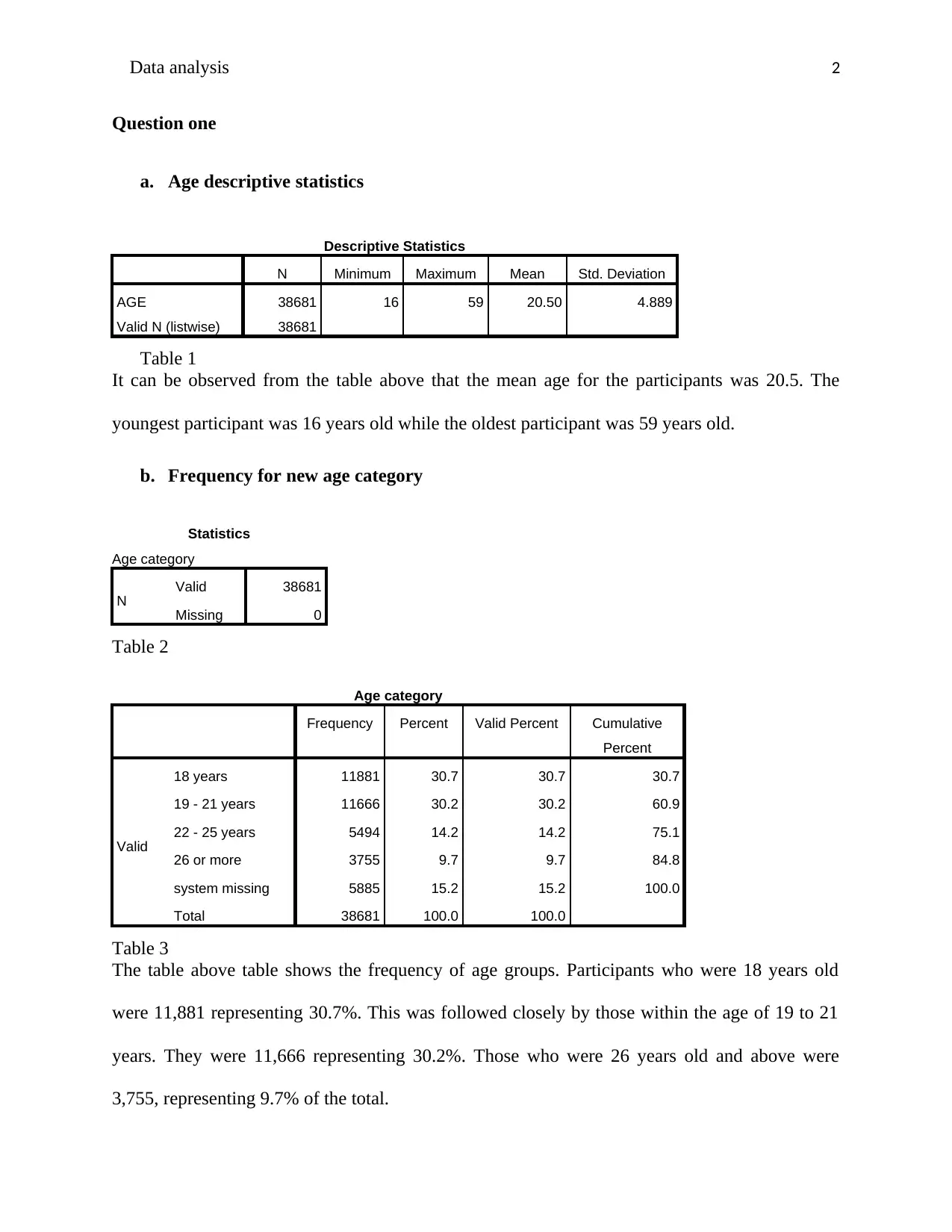
Data analysis 2
Question one
a. Age descriptive statistics
Descriptive Statistics
N Minimum Maximum Mean Std. Deviation
AGE 38681 16 59 20.50 4.889
Valid N (listwise) 38681
Table 1
It can be observed from the table above that the mean age for the participants was 20.5. The
youngest participant was 16 years old while the oldest participant was 59 years old.
b. Frequency for new age category
Statistics
Age category
N Valid 38681
Missing 0
Table 2
Age category
Frequency Percent Valid Percent Cumulative
Percent
Valid
18 years 11881 30.7 30.7 30.7
19 - 21 years 11666 30.2 30.2 60.9
22 - 25 years 5494 14.2 14.2 75.1
26 or more 3755 9.7 9.7 84.8
system missing 5885 15.2 15.2 100.0
Total 38681 100.0 100.0
Table 3
The table above table shows the frequency of age groups. Participants who were 18 years old
were 11,881 representing 30.7%. This was followed closely by those within the age of 19 to 21
years. They were 11,666 representing 30.2%. Those who were 26 years old and above were
3,755, representing 9.7% of the total.
Question one
a. Age descriptive statistics
Descriptive Statistics
N Minimum Maximum Mean Std. Deviation
AGE 38681 16 59 20.50 4.889
Valid N (listwise) 38681
Table 1
It can be observed from the table above that the mean age for the participants was 20.5. The
youngest participant was 16 years old while the oldest participant was 59 years old.
b. Frequency for new age category
Statistics
Age category
N Valid 38681
Missing 0
Table 2
Age category
Frequency Percent Valid Percent Cumulative
Percent
Valid
18 years 11881 30.7 30.7 30.7
19 - 21 years 11666 30.2 30.2 60.9
22 - 25 years 5494 14.2 14.2 75.1
26 or more 3755 9.7 9.7 84.8
system missing 5885 15.2 15.2 100.0
Total 38681 100.0 100.0
Table 3
The table above table shows the frequency of age groups. Participants who were 18 years old
were 11,881 representing 30.7%. This was followed closely by those within the age of 19 to 21
years. They were 11,666 representing 30.2%. Those who were 26 years old and above were
3,755, representing 9.7% of the total.
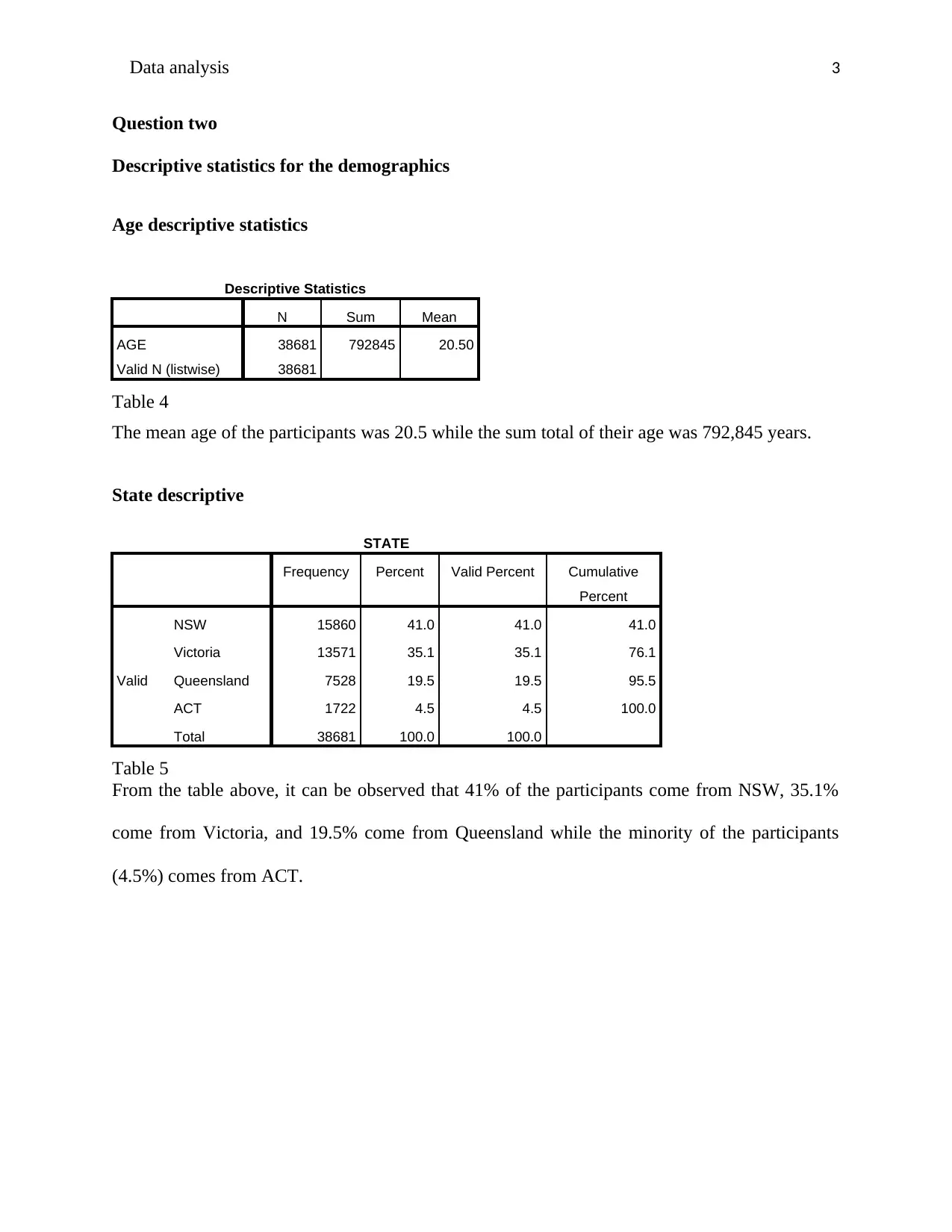
Data analysis 3
Question two
Descriptive statistics for the demographics
Age descriptive statistics
Descriptive Statistics
N Sum Mean
AGE 38681 792845 20.50
Valid N (listwise) 38681
Table 4
The mean age of the participants was 20.5 while the sum total of their age was 792,845 years.
State descriptive
STATE
Frequency Percent Valid Percent Cumulative
Percent
Valid
NSW 15860 41.0 41.0 41.0
Victoria 13571 35.1 35.1 76.1
Queensland 7528 19.5 19.5 95.5
ACT 1722 4.5 4.5 100.0
Total 38681 100.0 100.0
Table 5
From the table above, it can be observed that 41% of the participants come from NSW, 35.1%
come from Victoria, and 19.5% come from Queensland while the minority of the participants
(4.5%) comes from ACT.
Question two
Descriptive statistics for the demographics
Age descriptive statistics
Descriptive Statistics
N Sum Mean
AGE 38681 792845 20.50
Valid N (listwise) 38681
Table 4
The mean age of the participants was 20.5 while the sum total of their age was 792,845 years.
State descriptive
STATE
Frequency Percent Valid Percent Cumulative
Percent
Valid
NSW 15860 41.0 41.0 41.0
Victoria 13571 35.1 35.1 76.1
Queensland 7528 19.5 19.5 95.5
ACT 1722 4.5 4.5 100.0
Total 38681 100.0 100.0
Table 5
From the table above, it can be observed that 41% of the participants come from NSW, 35.1%
come from Victoria, and 19.5% come from Queensland while the minority of the participants
(4.5%) comes from ACT.
⊘ This is a preview!⊘
Do you want full access?
Subscribe today to unlock all pages.

Trusted by 1+ million students worldwide
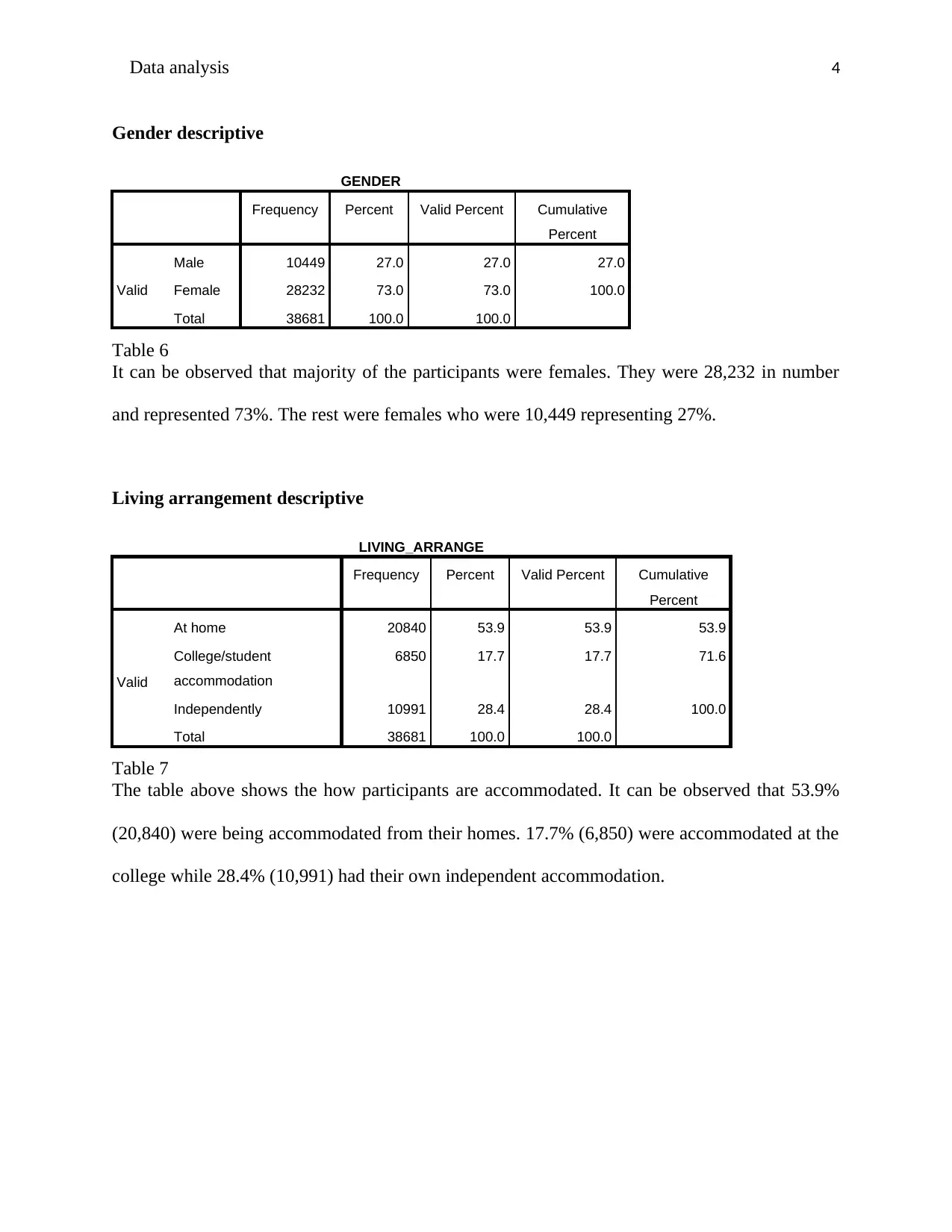
Data analysis 4
Gender descriptive
GENDER
Frequency Percent Valid Percent Cumulative
Percent
Valid
Male 10449 27.0 27.0 27.0
Female 28232 73.0 73.0 100.0
Total 38681 100.0 100.0
Table 6
It can be observed that majority of the participants were females. They were 28,232 in number
and represented 73%. The rest were females who were 10,449 representing 27%.
Living arrangement descriptive
LIVING_ARRANGE
Frequency Percent Valid Percent Cumulative
Percent
Valid
At home 20840 53.9 53.9 53.9
College/student
accommodation
6850 17.7 17.7 71.6
Independently 10991 28.4 28.4 100.0
Total 38681 100.0 100.0
Table 7
The table above shows the how participants are accommodated. It can be observed that 53.9%
(20,840) were being accommodated from their homes. 17.7% (6,850) were accommodated at the
college while 28.4% (10,991) had their own independent accommodation.
Gender descriptive
GENDER
Frequency Percent Valid Percent Cumulative
Percent
Valid
Male 10449 27.0 27.0 27.0
Female 28232 73.0 73.0 100.0
Total 38681 100.0 100.0
Table 6
It can be observed that majority of the participants were females. They were 28,232 in number
and represented 73%. The rest were females who were 10,449 representing 27%.
Living arrangement descriptive
LIVING_ARRANGE
Frequency Percent Valid Percent Cumulative
Percent
Valid
At home 20840 53.9 53.9 53.9
College/student
accommodation
6850 17.7 17.7 71.6
Independently 10991 28.4 28.4 100.0
Total 38681 100.0 100.0
Table 7
The table above shows the how participants are accommodated. It can be observed that 53.9%
(20,840) were being accommodated from their homes. 17.7% (6,850) were accommodated at the
college while 28.4% (10,991) had their own independent accommodation.
Paraphrase This Document
Need a fresh take? Get an instant paraphrase of this document with our AI Paraphraser
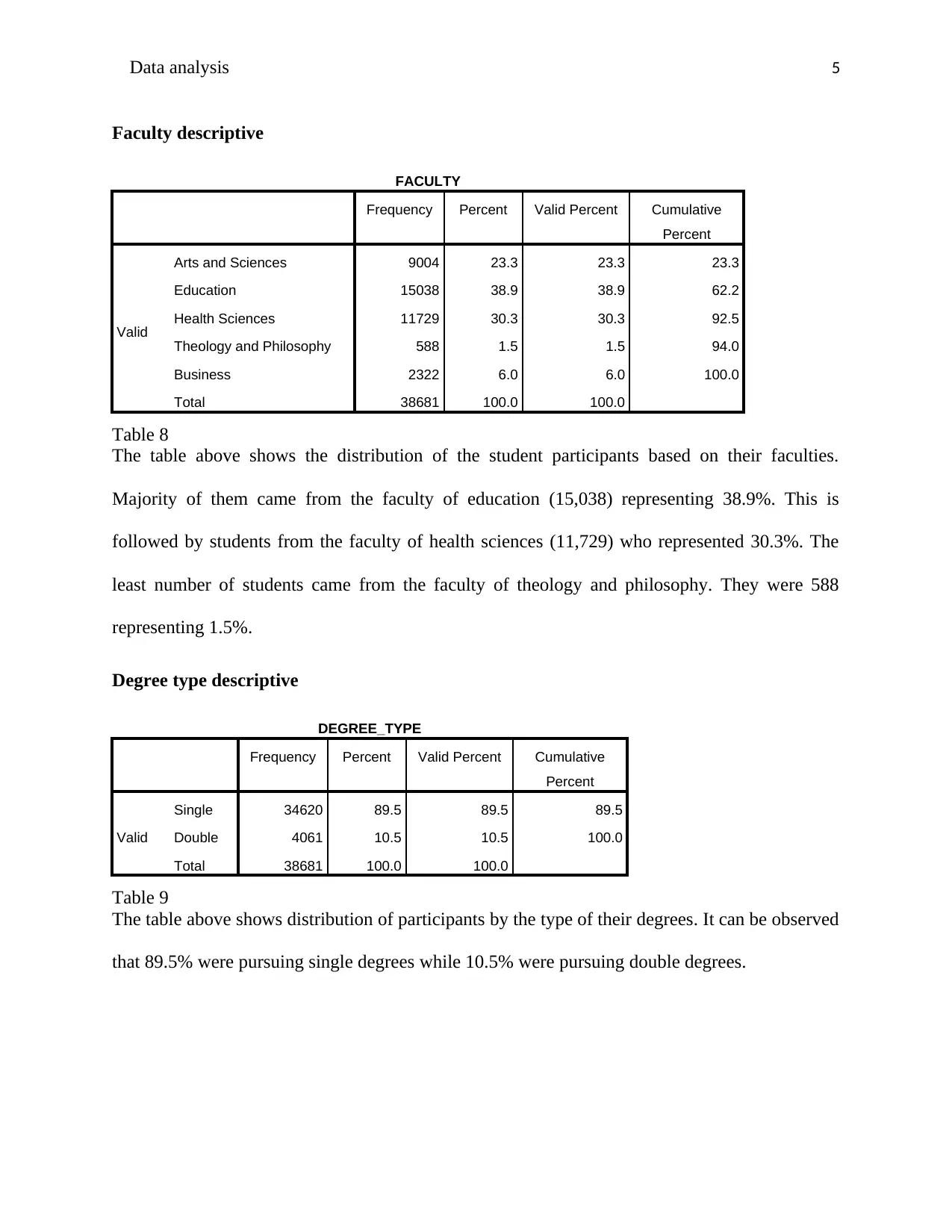
Data analysis 5
Faculty descriptive
FACULTY
Frequency Percent Valid Percent Cumulative
Percent
Valid
Arts and Sciences 9004 23.3 23.3 23.3
Education 15038 38.9 38.9 62.2
Health Sciences 11729 30.3 30.3 92.5
Theology and Philosophy 588 1.5 1.5 94.0
Business 2322 6.0 6.0 100.0
Total 38681 100.0 100.0
Table 8
The table above shows the distribution of the student participants based on their faculties.
Majority of them came from the faculty of education (15,038) representing 38.9%. This is
followed by students from the faculty of health sciences (11,729) who represented 30.3%. The
least number of students came from the faculty of theology and philosophy. They were 588
representing 1.5%.
Degree type descriptive
DEGREE_TYPE
Frequency Percent Valid Percent Cumulative
Percent
Valid
Single 34620 89.5 89.5 89.5
Double 4061 10.5 10.5 100.0
Total 38681 100.0 100.0
Table 9
The table above shows distribution of participants by the type of their degrees. It can be observed
that 89.5% were pursuing single degrees while 10.5% were pursuing double degrees.
Faculty descriptive
FACULTY
Frequency Percent Valid Percent Cumulative
Percent
Valid
Arts and Sciences 9004 23.3 23.3 23.3
Education 15038 38.9 38.9 62.2
Health Sciences 11729 30.3 30.3 92.5
Theology and Philosophy 588 1.5 1.5 94.0
Business 2322 6.0 6.0 100.0
Total 38681 100.0 100.0
Table 8
The table above shows the distribution of the student participants based on their faculties.
Majority of them came from the faculty of education (15,038) representing 38.9%. This is
followed by students from the faculty of health sciences (11,729) who represented 30.3%. The
least number of students came from the faculty of theology and philosophy. They were 588
representing 1.5%.
Degree type descriptive
DEGREE_TYPE
Frequency Percent Valid Percent Cumulative
Percent
Valid
Single 34620 89.5 89.5 89.5
Double 4061 10.5 10.5 100.0
Total 38681 100.0 100.0
Table 9
The table above shows distribution of participants by the type of their degrees. It can be observed
that 89.5% were pursuing single degrees while 10.5% were pursuing double degrees.

Data analysis 6
Metro descriptive
METRO
Frequency Percent Valid Percent Cumulative
Percent
Valid
Metro 27223 70.4 84.4 84.4
Non-metro 5015 13.0 15.6 100.0
Total 32238 83.3 100.0
Missing System 6443 16.7
Total 38681 100.0
Table 10
The table above shows the location of origin of the students. It can be observed that majority of
them came from metropolitan areas (70.4%) while 13% came from non-metropolitan areas.
Study mode descriptive
STUDY_MODE
Frequency Percent Valid Percent Cumulative
Percent
Valid
FT 34770 89.9 89.9 89.9
PT 3911 10.1 10.1 100.0
Total 38681 100.0 100.0
Table 11
From the table above, it can be observed that 89.9% of the students pursued full time studies
while 10.1% pursued part time studies.
Fee status descriptive
FEE_STATUS
Frequency Percent Valid Percent Cumulative
Percent
Valid
Domestic 32238 83.3 83.3 83.3
International 6443 16.7 16.7 100.0
Total 38681 100.0 100.0
Table 12
Metro descriptive
METRO
Frequency Percent Valid Percent Cumulative
Percent
Valid
Metro 27223 70.4 84.4 84.4
Non-metro 5015 13.0 15.6 100.0
Total 32238 83.3 100.0
Missing System 6443 16.7
Total 38681 100.0
Table 10
The table above shows the location of origin of the students. It can be observed that majority of
them came from metropolitan areas (70.4%) while 13% came from non-metropolitan areas.
Study mode descriptive
STUDY_MODE
Frequency Percent Valid Percent Cumulative
Percent
Valid
FT 34770 89.9 89.9 89.9
PT 3911 10.1 10.1 100.0
Total 38681 100.0 100.0
Table 11
From the table above, it can be observed that 89.9% of the students pursued full time studies
while 10.1% pursued part time studies.
Fee status descriptive
FEE_STATUS
Frequency Percent Valid Percent Cumulative
Percent
Valid
Domestic 32238 83.3 83.3 83.3
International 6443 16.7 16.7 100.0
Total 38681 100.0 100.0
Table 12
⊘ This is a preview!⊘
Do you want full access?
Subscribe today to unlock all pages.

Trusted by 1+ million students worldwide
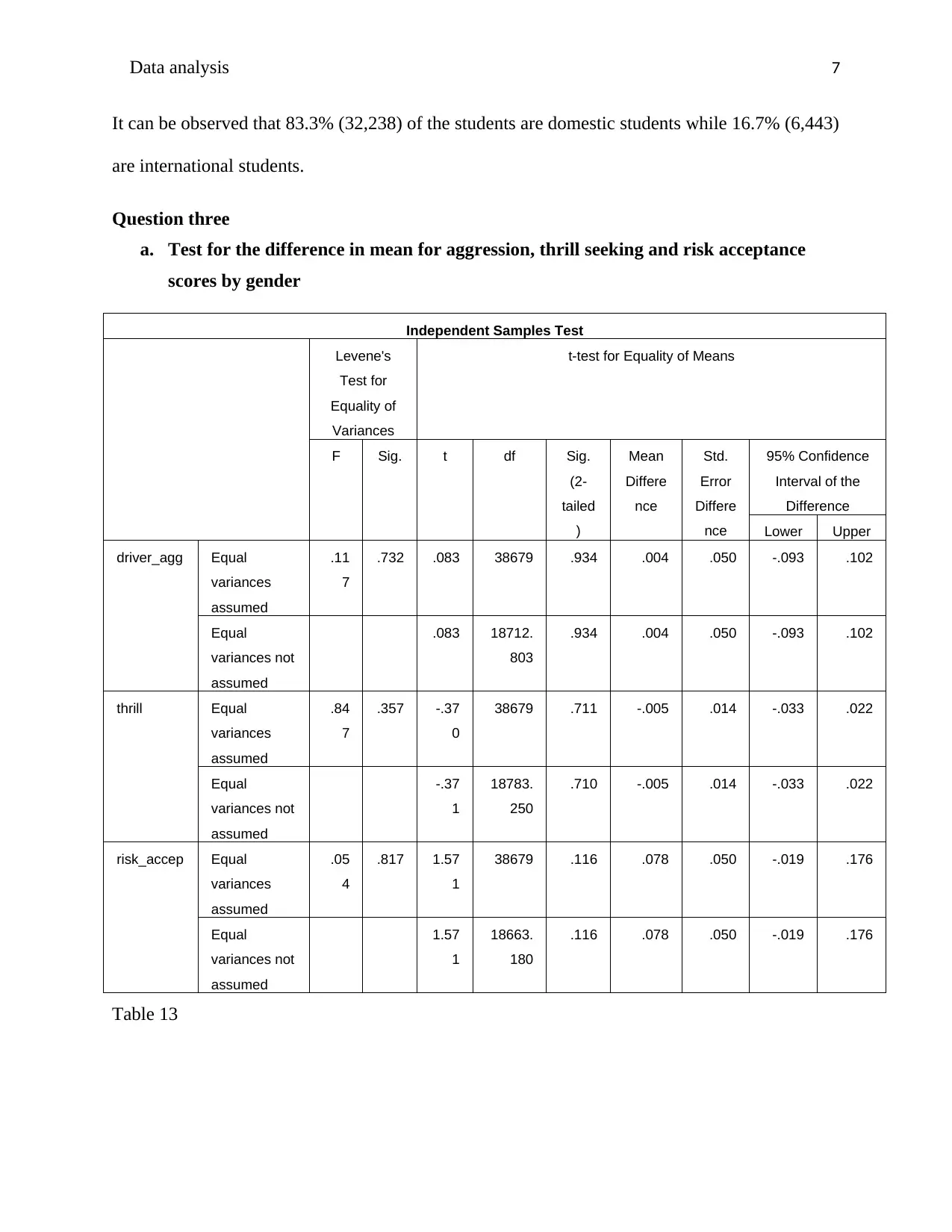
Data analysis 7
It can be observed that 83.3% (32,238) of the students are domestic students while 16.7% (6,443)
are international students.
Question three
a. Test for the difference in mean for aggression, thrill seeking and risk acceptance
scores by gender
Independent Samples Test
Levene's
Test for
Equality of
Variances
t-test for Equality of Means
F Sig. t df Sig.
(2-
tailed
)
Mean
Differe
nce
Std.
Error
Differe
nce
95% Confidence
Interval of the
Difference
Lower Upper
driver_agg Equal
variances
assumed
.11
7
.732 .083 38679 .934 .004 .050 -.093 .102
Equal
variances not
assumed
.083 18712.
803
.934 .004 .050 -.093 .102
thrill Equal
variances
assumed
.84
7
.357 -.37
0
38679 .711 -.005 .014 -.033 .022
Equal
variances not
assumed
-.37
1
18783.
250
.710 -.005 .014 -.033 .022
risk_accep Equal
variances
assumed
.05
4
.817 1.57
1
38679 .116 .078 .050 -.019 .176
Equal
variances not
assumed
1.57
1
18663.
180
.116 .078 .050 -.019 .176
Table 13
It can be observed that 83.3% (32,238) of the students are domestic students while 16.7% (6,443)
are international students.
Question three
a. Test for the difference in mean for aggression, thrill seeking and risk acceptance
scores by gender
Independent Samples Test
Levene's
Test for
Equality of
Variances
t-test for Equality of Means
F Sig. t df Sig.
(2-
tailed
)
Mean
Differe
nce
Std.
Error
Differe
nce
95% Confidence
Interval of the
Difference
Lower Upper
driver_agg Equal
variances
assumed
.11
7
.732 .083 38679 .934 .004 .050 -.093 .102
Equal
variances not
assumed
.083 18712.
803
.934 .004 .050 -.093 .102
thrill Equal
variances
assumed
.84
7
.357 -.37
0
38679 .711 -.005 .014 -.033 .022
Equal
variances not
assumed
-.37
1
18783.
250
.710 -.005 .014 -.033 .022
risk_accep Equal
variances
assumed
.05
4
.817 1.57
1
38679 .116 .078 .050 -.019 .176
Equal
variances not
assumed
1.57
1
18663.
180
.116 .078 .050 -.019 .176
Table 13
Paraphrase This Document
Need a fresh take? Get an instant paraphrase of this document with our AI Paraphraser
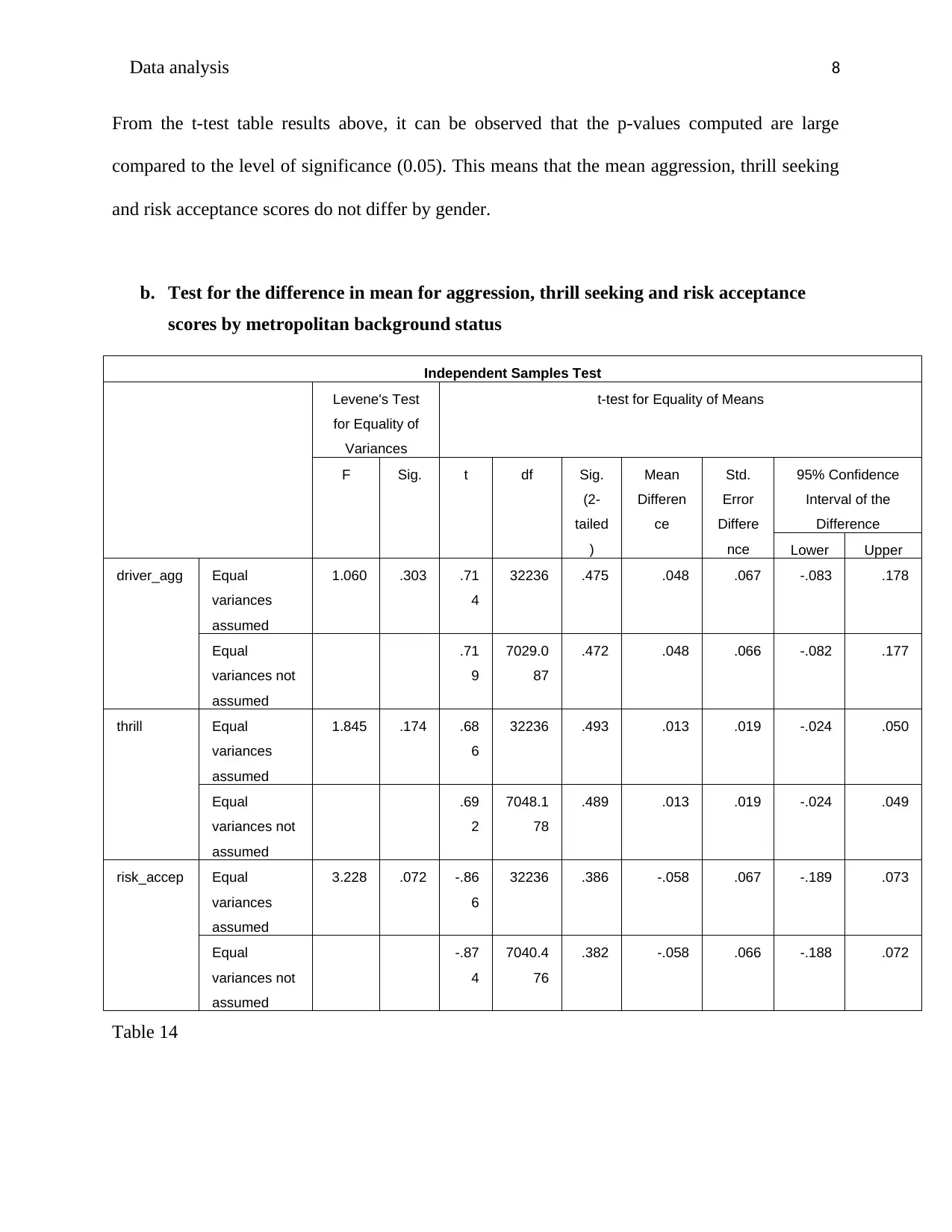
Data analysis 8
From the t-test table results above, it can be observed that the p-values computed are large
compared to the level of significance (0.05). This means that the mean aggression, thrill seeking
and risk acceptance scores do not differ by gender.
b. Test for the difference in mean for aggression, thrill seeking and risk acceptance
scores by metropolitan background status
Independent Samples Test
Levene's Test
for Equality of
Variances
t-test for Equality of Means
F Sig. t df Sig.
(2-
tailed
)
Mean
Differen
ce
Std.
Error
Differe
nce
95% Confidence
Interval of the
Difference
Lower Upper
driver_agg Equal
variances
assumed
1.060 .303 .71
4
32236 .475 .048 .067 -.083 .178
Equal
variances not
assumed
.71
9
7029.0
87
.472 .048 .066 -.082 .177
thrill Equal
variances
assumed
1.845 .174 .68
6
32236 .493 .013 .019 -.024 .050
Equal
variances not
assumed
.69
2
7048.1
78
.489 .013 .019 -.024 .049
risk_accep Equal
variances
assumed
3.228 .072 -.86
6
32236 .386 -.058 .067 -.189 .073
Equal
variances not
assumed
-.87
4
7040.4
76
.382 -.058 .066 -.188 .072
Table 14
From the t-test table results above, it can be observed that the p-values computed are large
compared to the level of significance (0.05). This means that the mean aggression, thrill seeking
and risk acceptance scores do not differ by gender.
b. Test for the difference in mean for aggression, thrill seeking and risk acceptance
scores by metropolitan background status
Independent Samples Test
Levene's Test
for Equality of
Variances
t-test for Equality of Means
F Sig. t df Sig.
(2-
tailed
)
Mean
Differen
ce
Std.
Error
Differe
nce
95% Confidence
Interval of the
Difference
Lower Upper
driver_agg Equal
variances
assumed
1.060 .303 .71
4
32236 .475 .048 .067 -.083 .178
Equal
variances not
assumed
.71
9
7029.0
87
.472 .048 .066 -.082 .177
thrill Equal
variances
assumed
1.845 .174 .68
6
32236 .493 .013 .019 -.024 .050
Equal
variances not
assumed
.69
2
7048.1
78
.489 .013 .019 -.024 .049
risk_accep Equal
variances
assumed
3.228 .072 -.86
6
32236 .386 -.058 .067 -.189 .073
Equal
variances not
assumed
-.87
4
7040.4
76
.382 -.058 .066 -.188 .072
Table 14
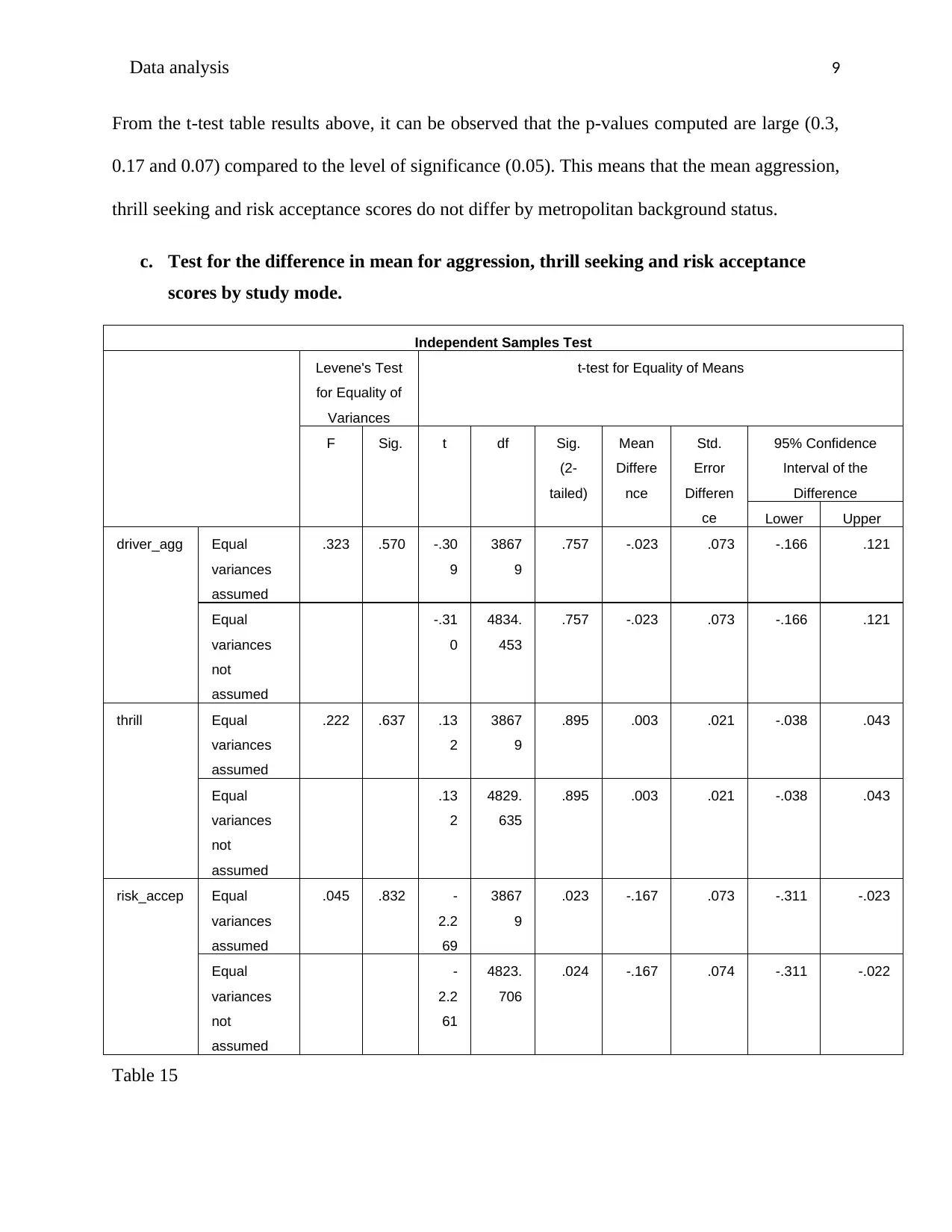
Data analysis 9
From the t-test table results above, it can be observed that the p-values computed are large (0.3,
0.17 and 0.07) compared to the level of significance (0.05). This means that the mean aggression,
thrill seeking and risk acceptance scores do not differ by metropolitan background status.
c. Test for the difference in mean for aggression, thrill seeking and risk acceptance
scores by study mode.
Independent Samples Test
Levene's Test
for Equality of
Variances
t-test for Equality of Means
F Sig. t df Sig.
(2-
tailed)
Mean
Differe
nce
Std.
Error
Differen
ce
95% Confidence
Interval of the
Difference
Lower Upper
driver_agg Equal
variances
assumed
.323 .570 -.30
9
3867
9
.757 -.023 .073 -.166 .121
Equal
variances
not
assumed
-.31
0
4834.
453
.757 -.023 .073 -.166 .121
thrill Equal
variances
assumed
.222 .637 .13
2
3867
9
.895 .003 .021 -.038 .043
Equal
variances
not
assumed
.13
2
4829.
635
.895 .003 .021 -.038 .043
risk_accep Equal
variances
assumed
.045 .832 -
2.2
69
3867
9
.023 -.167 .073 -.311 -.023
Equal
variances
not
assumed
-
2.2
61
4823.
706
.024 -.167 .074 -.311 -.022
Table 15
From the t-test table results above, it can be observed that the p-values computed are large (0.3,
0.17 and 0.07) compared to the level of significance (0.05). This means that the mean aggression,
thrill seeking and risk acceptance scores do not differ by metropolitan background status.
c. Test for the difference in mean for aggression, thrill seeking and risk acceptance
scores by study mode.
Independent Samples Test
Levene's Test
for Equality of
Variances
t-test for Equality of Means
F Sig. t df Sig.
(2-
tailed)
Mean
Differe
nce
Std.
Error
Differen
ce
95% Confidence
Interval of the
Difference
Lower Upper
driver_agg Equal
variances
assumed
.323 .570 -.30
9
3867
9
.757 -.023 .073 -.166 .121
Equal
variances
not
assumed
-.31
0
4834.
453
.757 -.023 .073 -.166 .121
thrill Equal
variances
assumed
.222 .637 .13
2
3867
9
.895 .003 .021 -.038 .043
Equal
variances
not
assumed
.13
2
4829.
635
.895 .003 .021 -.038 .043
risk_accep Equal
variances
assumed
.045 .832 -
2.2
69
3867
9
.023 -.167 .073 -.311 -.023
Equal
variances
not
assumed
-
2.2
61
4823.
706
.024 -.167 .074 -.311 -.022
Table 15
⊘ This is a preview!⊘
Do you want full access?
Subscribe today to unlock all pages.

Trusted by 1+ million students worldwide
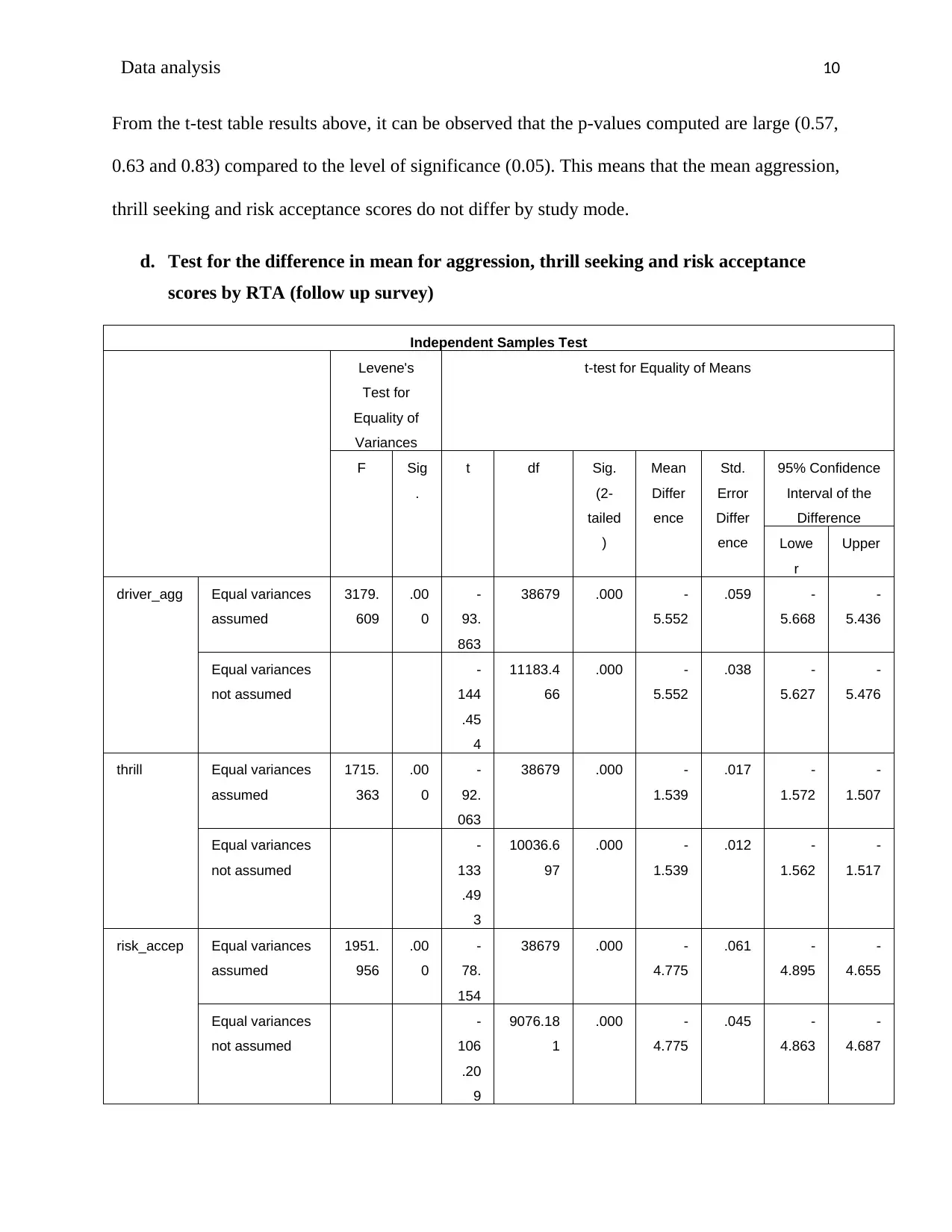
Data analysis 10
From the t-test table results above, it can be observed that the p-values computed are large (0.57,
0.63 and 0.83) compared to the level of significance (0.05). This means that the mean aggression,
thrill seeking and risk acceptance scores do not differ by study mode.
d. Test for the difference in mean for aggression, thrill seeking and risk acceptance
scores by RTA (follow up survey)
Independent Samples Test
Levene's
Test for
Equality of
Variances
t-test for Equality of Means
F Sig
.
t df Sig.
(2-
tailed
)
Mean
Differ
ence
Std.
Error
Differ
ence
95% Confidence
Interval of the
Difference
Lowe
r
Upper
driver_agg Equal variances
assumed
3179.
609
.00
0
-
93.
863
38679 .000 -
5.552
.059 -
5.668
-
5.436
Equal variances
not assumed
-
144
.45
4
11183.4
66
.000 -
5.552
.038 -
5.627
-
5.476
thrill Equal variances
assumed
1715.
363
.00
0
-
92.
063
38679 .000 -
1.539
.017 -
1.572
-
1.507
Equal variances
not assumed
-
133
.49
3
10036.6
97
.000 -
1.539
.012 -
1.562
-
1.517
risk_accep Equal variances
assumed
1951.
956
.00
0
-
78.
154
38679 .000 -
4.775
.061 -
4.895
-
4.655
Equal variances
not assumed
-
106
.20
9
9076.18
1
.000 -
4.775
.045 -
4.863
-
4.687
From the t-test table results above, it can be observed that the p-values computed are large (0.57,
0.63 and 0.83) compared to the level of significance (0.05). This means that the mean aggression,
thrill seeking and risk acceptance scores do not differ by study mode.
d. Test for the difference in mean for aggression, thrill seeking and risk acceptance
scores by RTA (follow up survey)
Independent Samples Test
Levene's
Test for
Equality of
Variances
t-test for Equality of Means
F Sig
.
t df Sig.
(2-
tailed
)
Mean
Differ
ence
Std.
Error
Differ
ence
95% Confidence
Interval of the
Difference
Lowe
r
Upper
driver_agg Equal variances
assumed
3179.
609
.00
0
-
93.
863
38679 .000 -
5.552
.059 -
5.668
-
5.436
Equal variances
not assumed
-
144
.45
4
11183.4
66
.000 -
5.552
.038 -
5.627
-
5.476
thrill Equal variances
assumed
1715.
363
.00
0
-
92.
063
38679 .000 -
1.539
.017 -
1.572
-
1.507
Equal variances
not assumed
-
133
.49
3
10036.6
97
.000 -
1.539
.012 -
1.562
-
1.517
risk_accep Equal variances
assumed
1951.
956
.00
0
-
78.
154
38679 .000 -
4.775
.061 -
4.895
-
4.655
Equal variances
not assumed
-
106
.20
9
9076.18
1
.000 -
4.775
.045 -
4.863
-
4.687
Paraphrase This Document
Need a fresh take? Get an instant paraphrase of this document with our AI Paraphraser

Data analysis 11
Table 16
From the t-test table results above, it can be observed that the p-values computed are less (0.00)
compared to the level of significance (0.05). This means that the mean aggression, thrill seeking
and risk acceptance scores differ significantly by RTA.
Question four
a. Depression by gender
Table of results
ANOVA
depression
Sum of Squares df Mean Square F Sig.
Between Groups .026 1 .026 .280 .597
Within Groups 3555.361 38679 .092
Total 3555.387 38680
Table 17
The anova results show that the computed p-value (0.57) is greater compared to the level of
significance (0.05). This means that the null hypothesis is accepted. It is concluded therefore that
null hypothesis is significant at 95% level of confidence.
b. Depression by metropolitan background status
Results table
ANOVA
depression
Sum of Squares df Mean Square F Sig.
Between Groups .010 1 .010 .114 .736
Within Groups 2962.189 32236 .092
Total 2962.200 32237
Table 18
Table 16
From the t-test table results above, it can be observed that the p-values computed are less (0.00)
compared to the level of significance (0.05). This means that the mean aggression, thrill seeking
and risk acceptance scores differ significantly by RTA.
Question four
a. Depression by gender
Table of results
ANOVA
depression
Sum of Squares df Mean Square F Sig.
Between Groups .026 1 .026 .280 .597
Within Groups 3555.361 38679 .092
Total 3555.387 38680
Table 17
The anova results show that the computed p-value (0.57) is greater compared to the level of
significance (0.05). This means that the null hypothesis is accepted. It is concluded therefore that
null hypothesis is significant at 95% level of confidence.
b. Depression by metropolitan background status
Results table
ANOVA
depression
Sum of Squares df Mean Square F Sig.
Between Groups .010 1 .010 .114 .736
Within Groups 2962.189 32236 .092
Total 2962.200 32237
Table 18
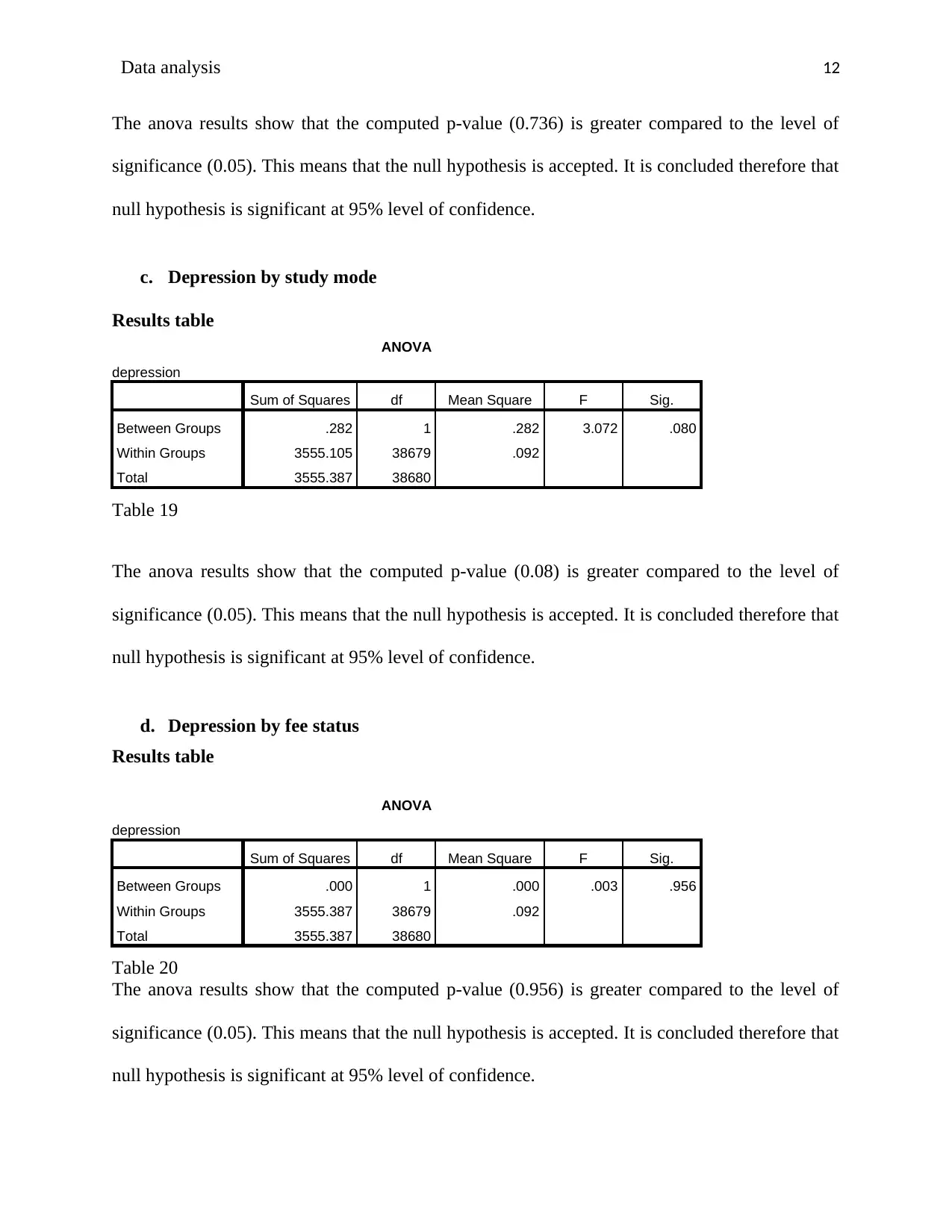
Data analysis 12
The anova results show that the computed p-value (0.736) is greater compared to the level of
significance (0.05). This means that the null hypothesis is accepted. It is concluded therefore that
null hypothesis is significant at 95% level of confidence.
c. Depression by study mode
Results table
ANOVA
depression
Sum of Squares df Mean Square F Sig.
Between Groups .282 1 .282 3.072 .080
Within Groups 3555.105 38679 .092
Total 3555.387 38680
Table 19
The anova results show that the computed p-value (0.08) is greater compared to the level of
significance (0.05). This means that the null hypothesis is accepted. It is concluded therefore that
null hypothesis is significant at 95% level of confidence.
d. Depression by fee status
Results table
ANOVA
depression
Sum of Squares df Mean Square F Sig.
Between Groups .000 1 .000 .003 .956
Within Groups 3555.387 38679 .092
Total 3555.387 38680
Table 20
The anova results show that the computed p-value (0.956) is greater compared to the level of
significance (0.05). This means that the null hypothesis is accepted. It is concluded therefore that
null hypothesis is significant at 95% level of confidence.
The anova results show that the computed p-value (0.736) is greater compared to the level of
significance (0.05). This means that the null hypothesis is accepted. It is concluded therefore that
null hypothesis is significant at 95% level of confidence.
c. Depression by study mode
Results table
ANOVA
depression
Sum of Squares df Mean Square F Sig.
Between Groups .282 1 .282 3.072 .080
Within Groups 3555.105 38679 .092
Total 3555.387 38680
Table 19
The anova results show that the computed p-value (0.08) is greater compared to the level of
significance (0.05). This means that the null hypothesis is accepted. It is concluded therefore that
null hypothesis is significant at 95% level of confidence.
d. Depression by fee status
Results table
ANOVA
depression
Sum of Squares df Mean Square F Sig.
Between Groups .000 1 .000 .003 .956
Within Groups 3555.387 38679 .092
Total 3555.387 38680
Table 20
The anova results show that the computed p-value (0.956) is greater compared to the level of
significance (0.05). This means that the null hypothesis is accepted. It is concluded therefore that
null hypothesis is significant at 95% level of confidence.
⊘ This is a preview!⊘
Do you want full access?
Subscribe today to unlock all pages.

Trusted by 1+ million students worldwide
1 out of 15
Related Documents
Your All-in-One AI-Powered Toolkit for Academic Success.
+13062052269
info@desklib.com
Available 24*7 on WhatsApp / Email
![[object Object]](/_next/static/media/star-bottom.7253800d.svg)
Unlock your academic potential
Copyright © 2020–2025 A2Z Services. All Rights Reserved. Developed and managed by ZUCOL.





